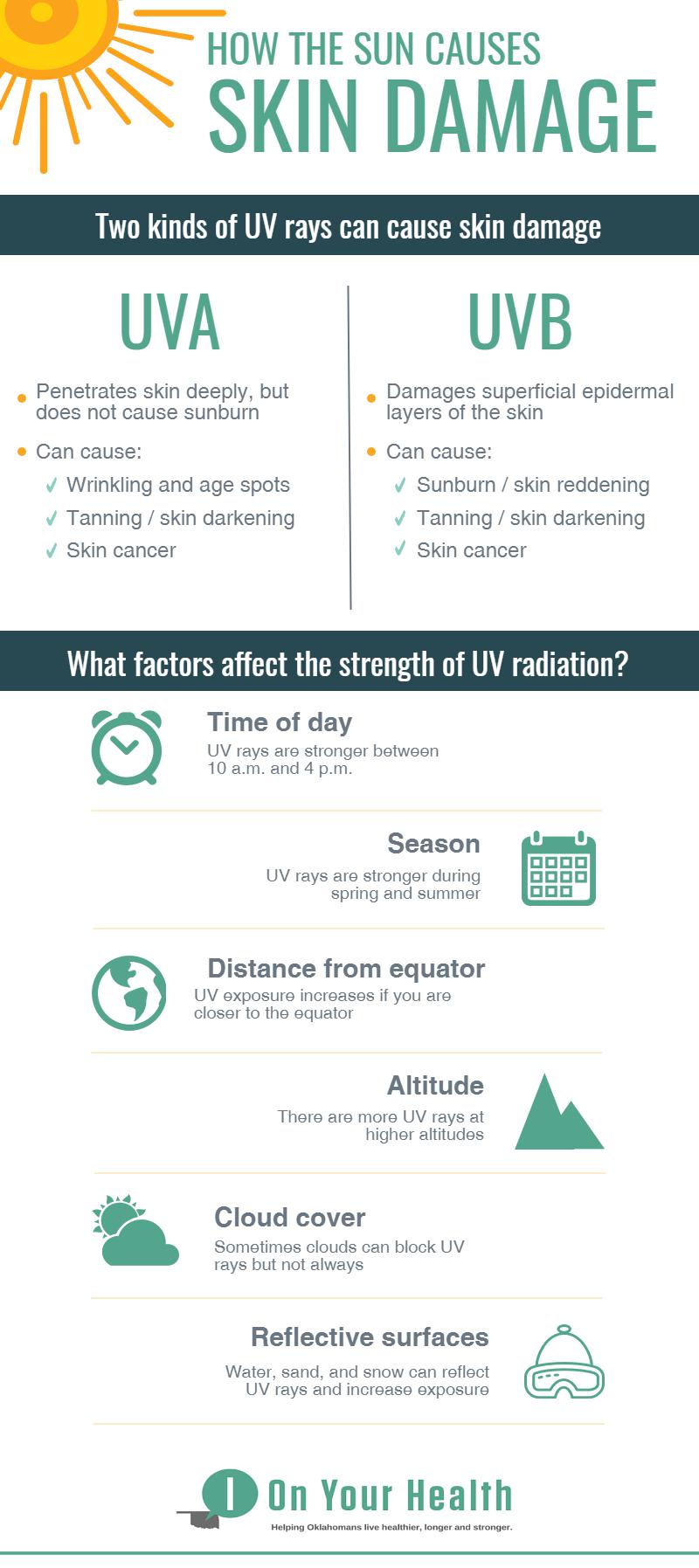Basics of Sunscreen
Posted in

Each year as summer approaches, many of us are eager to get outside, relax by the pool and add a summer glow to our winter skin. We trust our sunscreens to protect us from sunburn, skin damage and a higher risk of skin cancer. However, new research suggests what we thought we knew about sunscreen may not be true.
Skin cancer is the most common form of cancer, affecting more than three million people in the U.S. each year. Exposure to the sun’s ultraviolet (UV) rays is the most common risk factor contributing to skin cancer formation, but there are many ways to protect your skin from sunburns, aging and skin cancer. Understanding how the sun causes skin damage and how sunscreen works to protect against damaging UV rays can help you minimize exposure and decrease your risk of developing skin cancer.
How the sun causes skin damage
Two kinds of UV radiation cause skin damage: UVB and UVA. Most people are aware of UVB rays, which cause sunburn and increase risk of developing skin cancer. All sunscreens with an SPF (sun protection factor) rating protect against UVB rays. UVA rays are more difficult to detect because they don’t cause sunburns. However, they are more prevalent year-round and cause age spots, wrinkles and contribute to the development of some forms of skin cancer.
“UV rays can damage the skin, and as repeat damage builds up, it increases your risk for skin cancer,” INTEGRIS dermatologist Allyson Black, M.D. says.
The infographic below explains the difference between UVA and UVB rays, as well as the factors that can increase exposure throughout the year.

How sunscreen works
Sunscreen is made up of chemical and organic materials that protect against the sun’s UV rays. A sunscreen’s SPF refers to how well the sunscreen protects against UVB rays. There is no standard for protection against UVA radiation. However, most broad spectrum sunscreens protect against both UVB and UVA rays.
Wearing sunscreen every day, year-round is one of the best ways to protect your skin from damaging UV rays. So how can you be sure your sunscreen is working properly? A variety of factors could be at play. Apply one ounce of sunscreen – Most people do not apply enough sunscreen. The SPF rating on the bottle is typically based on using one ounce (equivalent to a full shot glass) with each application. Applying less than the recommended amount can decrease the SPF of your sunscreen.
Shake bottle well with each use – Active ingredients in sunscreen can become unevenly distributed. Shake the bottle well before each application to disperse the active ingredients. Reapply every two hours – While many sunscreens claim to last more than two hours, the Skin Cancer Foundation recommends reapplying every two hours regardless of strength. Even water-resistant sunscreens can wash off while swimming or sweating. Apply daily – “Sunscreen is recommended every day when you are outside. The sun’s harmful rays are still present on cloudy days,” Dr. Black says. Additionally, reflective surfaces like snow and water can actually increase UV exposure throughout fall and winter.
What to look for in an effective sunscreen
It can be difficult to determine which sunscreens effectively protect skin from both UVB and UVA rays. While there is no perfect method for choosing the right sunscreen, here are a few things to look for on your sunscreen label.
Broad spectrum - Even though UVA rays can’t cause sunburns, they are just as dangerous as UVB rays. Make sure you choose a broad spectrum sunscreen to protect against both kinds of damaging radiation. Most broad spectrum sunscreens contain PABA derivatives, salicylates, or cinnamates for UVB absorption, as well as benzophenones, avobenzone, exacsule, titanium dioxide or zinc oxide for UVA protection.
Sun protection factor (SPF) – The American Academy of Dermatology recommends using sunscreen with an SPF of at least 30. The SPF rating determines how many times longer your sunscreen will protect your skin from burning. For example, if you typically start burning within 10 minutes of unprotected sun exposure, SPF 15 will protect your skin for 150 minutes. Keep in mind that the SPF rating of your sunscreen is most accurate when using a full ounce of sunscreen over your body.
Water resistance – Water resistant sunscreen is recommended to help retain SPF through swimming and sweating. Water resistant sunscreens claim to be effective for either 40 or 80 minutes of submersion in water. Regardless, it is still recommended you re-apply at least every two hours.
Lotion – According to the American Association of Dermatology, the FDA continues to look into the efficacy of spray-on sunscreens. While they can be effective, it is much more difficult to determine how much sunscreen you’ve applied, and spray-on sunscreens can be toxic if sprayed on your face. Lotion sunscreens are preferred. However, if you do use spray-on sunscreen, make sure you spray a sufficient amount and rub it in evenly.
Brand – A recent Consumer Report showed not all sunscreen brands deliver the protection they promise. In the report, many brands failed to deliver the SPF rating advertised on their labels. Among the highest rated brands for effectiveness were La Roche-Posay Anthelios 60 Melt-in Sunscreen Milk ($36), Equate Sport Lotion, SPF 50 ($5), and Coppertone WaterBABIES Lotion, SPF 50 ($12). For more information on this report, watch the full clip from the Today Show.
Common misconceptions about sunscreen
One common misconception about sunscreen is that you only need to wear it if you are at a high risk of skin cancer or burn easily. “Sunscreen is recommended for everyone,” Dr. Black says. “Skin cancer can affect anyone, regardless of race, gender or age.”
In recent years, the chemical ingredients present in sunscreens have come under scrutiny. Both chemical and organic ingredients in sunscreens help to provide broad-spectrum protection from UVA and UVB rays. If you are concerned about the chemical ingredients in your sunscreen, refer to the Skin Cancer Foundation’s Guide to Sunscreens for FDA approved sunscreen ingredients and concentrations of each (Table 2).
Applying sunscreen to exposed skin daily is a great preventive measure to protect your skin against harmful UV rays.

